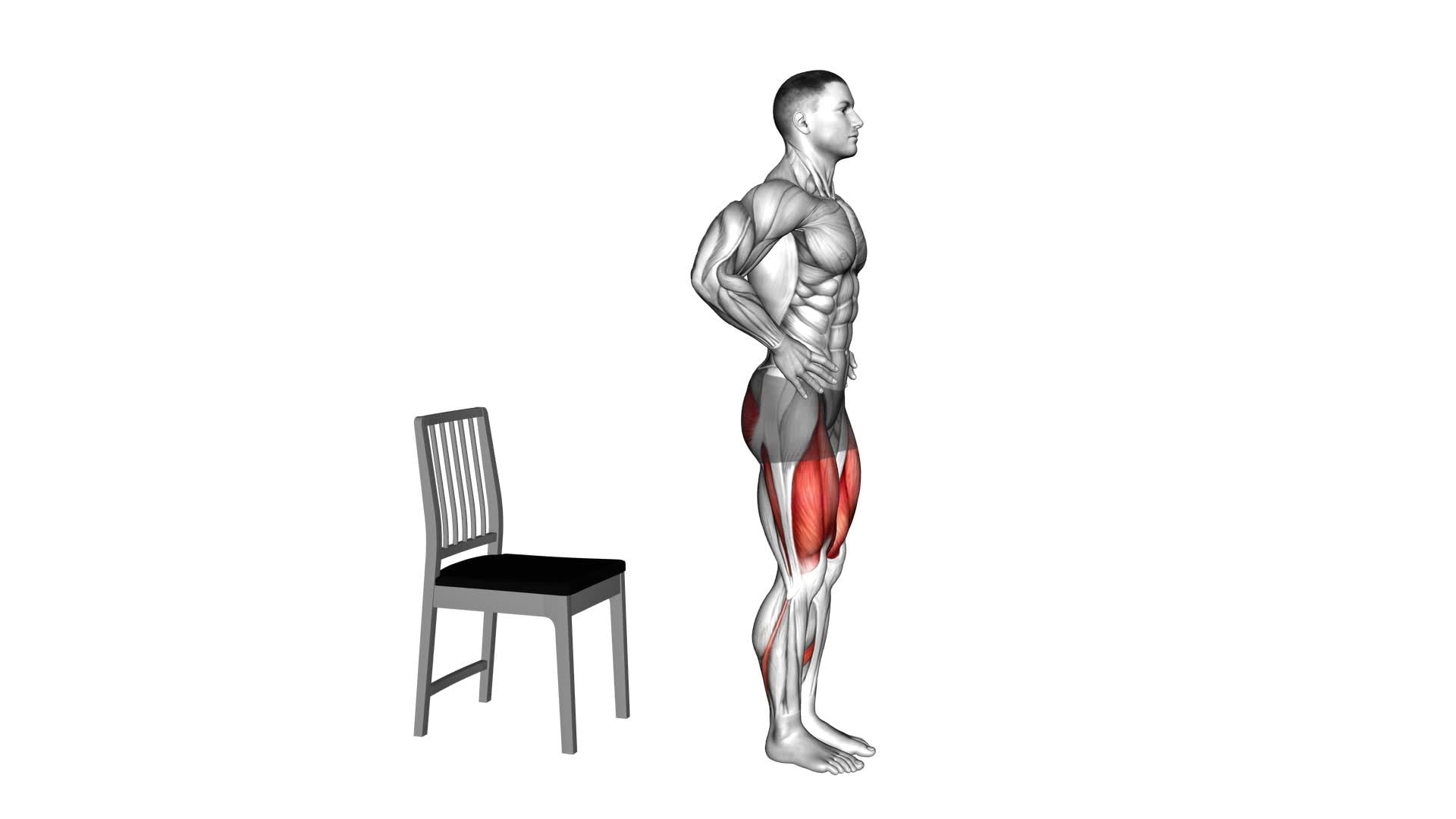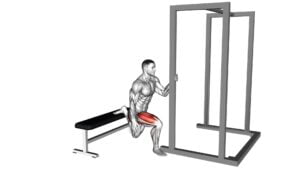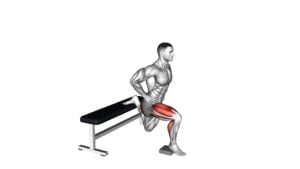Bulgarian Split Squat With Chair – Video Exercise Guide & Tips

Are you looking to amp up your leg workout? Look no further than the Bulgarian split squat with a chair.
Watch This Exercise Video
This exercise targets your quads, glutes, and hamstrings, giving you a killer lower body workout.
In this video exercise guide, we'll show you the proper form and technique to maximize your results.
Plus, we'll share tips on variations to challenge yourself and how to incorporate Bulgarian split squats into your workout routine.
Let's get those legs burning!
Key Takeaways
- Bulgarian Split Squats target quads, glutes, and hamstrings
- Proper form and technique include maintaining proper alignment and controlling the descent
- Common mistakes to avoid include not maintaining proper alignment and not engaging glutes and core muscles
- Variations to challenge yourself include elevated Bulgarian Split Squats and weighted Bulgarian Split Squats
Benefits of Bulgarian Split Squat
To maximize the effectiveness of your workout, incorporate the Bulgarian Split Squat for its numerous benefits.
This exercise is a great way to improve your balance and target your glutes. The Bulgarian Split Squat requires you to stand with one foot in front of the other, placing the back foot on an elevated surface such as a chair or step.
As you lower your body into a lunge position, make sure to keep your front knee in line with your toes and your back knee hovering just above the ground. By performing this exercise, you engage the muscles in your legs and core, while also challenging your balance and stability.
The Bulgarian Split Squat specifically targets your glutes, helping to strengthen and tone these muscles. This is especially beneficial for individuals looking to improve their lower body strength or enhance their athletic performance.
Additionally, the unilateral nature of this exercise can help to identify and correct any imbalances between the left and right sides of your body.
Incorporate the Bulgarian Split Squat into your workout routine to reap these incredible benefits.
Proper Form and Technique
To perform the Bulgarian Split Squat with proper form and technique, position yourself in front of a chair or step with one foot in front of the other, as explained in the previous subtopic. This exercise is often done incorrectly, so it's important to understand the proper form and technique to maximize its benefits and prevent injury.
Here are some key points to keep in mind:
- Maintain proper alignment: Keep your chest up, shoulders back, and core engaged throughout the exercise. This will help you maintain balance and stability.
- Control your descent: Lower yourself down slowly and with control, ensuring that your front knee stays in line with your ankle. Avoid letting your knee cave inwards or go past your toes.
- Push through your front heel: As you rise back up, focus on pushing through your front heel to engage your glutes and quadriceps effectively.
Common misconceptions about the Bulgarian Split Squat include using too much weight or relying too heavily on the back leg for support. Remember, the goal is to target the muscles of the front leg while maintaining stability and control.
No special equipment is necessary for this exercise, as you can use a chair or step as a platform. However, it's important to choose a sturdy and stable surface to ensure safety and proper execution.
Common Mistakes to Avoid
To avoid common mistakes in the Bulgarian Split Squat, it's important to be aware of certain key factors that can hinder proper form and technique.
One common mistake isn't maintaining proper alignment of the hips and knees. It's crucial to ensure that your front knee is directly above your ankle and your back knee is parallel to the ground. This will help prevent strain on your knees and maximize the effectiveness of the exercise.
Another common mistake isn't engaging the glutes and core muscles. These muscles play a key role in stabilizing your body during the movement and should be actively contracted throughout the exercise.
Additionally, it's important to avoid leaning too far forward or backward. This can throw off your balance and put unnecessary stress on your lower back. To maintain proper technique, keep your torso upright and your weight evenly distributed between your front and back legs.
Variations to Challenge Yourself
If you're looking to challenge yourself, try incorporating different variations of the Bulgarian Split Squat. Here are some advanced modifications and equipment options to take your split squat to the next level:
- Elevated Bulgarian Split Squat: Place your front foot on an elevated surface, such as a step or a block, to increase the range of motion and target your glutes and hamstrings even more.
- Weighted Bulgarian Split Squat: Hold a dumbbell or kettlebell in each hand to add resistance and increase the intensity of the exercise. This will help build strength and muscle in your lower body.
- Plyometric Bulgarian Split Squat: Add an explosive jump at the top of the movement to incorporate plyometric training. This will improve your power and athleticism.
These variations won't only challenge your muscles in different ways but also keep your workouts interesting and prevent boredom. Experiment with different combinations and find what works best for you.
Now that you know how to challenge yourself with different variations of the Bulgarian Split Squat, it's time to incorporate them into your workout routine.
Incorporating Bulgarian Split Squats Into Your Workout Routine
To incorporate Bulgarian Split Squats into your workout routine, start by selecting a suitable number of sets and repetitions to perform. The number of sets and reps will depend on your fitness level and goals. If you're a beginner, you may want to start with 2-3 sets of 8-10 reps on each leg. As you become more comfortable with the exercise, you can increase the number of sets and reps to challenge yourself.
One of the key benefits of single leg exercises like the Bulgarian Split Squat is that they help improve balance and stability. By working one leg at a time, you can correct any imbalances or weaknesses that may be present. This can help reduce the risk of injury and improve overall athletic performance.
To progress in split squats, you can add weight by holding dumbbells or using a barbell. This will increase the resistance and make the exercise more challenging. You can also try different variations, such as elevated split squats or jumping split squats, to further challenge your muscles.
Incorporating Bulgarian Split Squats into your workout routine can help you build strength, improve balance, and target different muscle groups. Remember to start with a suitable number of sets and reps, and gradually increase the intensity as you become stronger.
Frequently Asked Questions
How Many Repetitions Should I Do When Performing Bulgarian Split Squats?
When performing Bulgarian split squats, it's important to consider how many repetitions you should do. The number of sets and the proper form for Bulgarian split squats are also key factors.
By focusing on these aspects, you can maximize the effectiveness of this exercise and avoid potential injury.
Is It Necessary to Use a Chair for Bulgarian Split Squats, or Can I Use Other Equipment?
It's not necessary to use a chair for Bulgarian split squats; there are alternative equipment options available.
You can modify the exercise by using a stability ball, a step, or even just your bodyweight.
These modifications can help target different muscles and add variety to your workout routine.
It's important to choose the equipment that suits your needs and fitness level to ensure proper form and effectiveness.
Can Bulgarian Split Squats Help Improve My Balance and Stability?
Bulgarian split squats can definitely improve your balance and stability compared to traditional squats.
This exercise requires you to maintain proper form while working one leg at a time, which challenges your core and improves stability.
If you're a beginner, there are modifications you can make to ease into the exercise, such as using a chair for support or starting with a shorter range of motion.
Keep practicing and you'll see improvements in no time!
Are There Any Specific Muscles That Bulgarian Split Squats Target?
When performing Bulgarian split squats, you're targeting specific muscles in your lower body. This exercise primarily works your quadriceps, hamstrings, glutes, and calf muscles. By engaging these muscles, you can improve your strength, stability, and balance.
Bulgarian split squats also help to develop unilateral leg strength, which can be beneficial for sports performance and daily activities. Incorporating this exercise into your routine can have numerous benefits for your lower body strength and stability.
Can Bulgarian Split Squats Help With Improving My Overall Lower Body Strength?
Bulgarian split squats are a great exercise for improving overall lower body strength. By incorporating different variations of this exercise, you can target various muscles including the glutes, quads, and hamstrings.
Athletes can benefit from Bulgarian split squats as they help build stability, balance, and power in the lower body. Whether you're a runner, a weightlifter, or just looking to strengthen your legs, adding Bulgarian split squats to your routine can be highly effective.
Conclusion
Incorporating Bulgarian split squats into your workout routine is a great way to target your lower body muscles and improve your overall strength and stability. By using proper form and technique, you can maximize the benefits of this exercise and avoid common mistakes.
Additionally, you can challenge yourself by trying different variations of the split squat. So grab a chair and get ready to take your leg workout to the next level with the Bulgarian split squat!

Author
Years ago, the spark of my life’s passion ignited in my mind the moment I stepped into the local gym for the first time. The inaugural bead of perspiration, the initial endeavor, the very first surge of endorphins, and a sense of pride that washed over me post-workout marked the beginning of my deep-seated interest in strength sports, fitness, and sports nutrition. This very curiosity blossomed rapidly into a profound fascination, propelling me to earn a Master’s degree in Physical Education from the Academy of Physical Education in Krakow, followed by a Sports Manager diploma from the Jagiellonian University. My journey of growth led me to gain more specialized qualifications, such as being a certified personal trainer with a focus on sports dietetics, a lifeguard, and an instructor for wellness and corrective gymnastics. Theoretical knowledge paired seamlessly with practical experience, reinforcing my belief that the transformation of individuals under my guidance was also a reflection of my personal growth. This belief holds true even today. Each day, I strive to push the boundaries and explore new realms. These realms gently elevate me to greater heights. The unique combination of passion for my field and the continuous quest for growth fuels my drive to break new ground.







